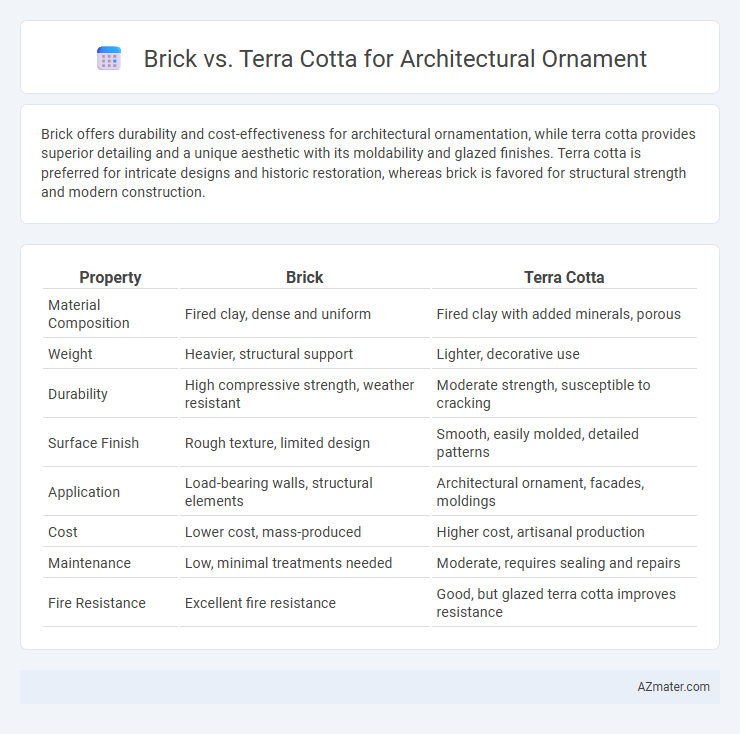Brick offers durability and cost-effectiveness for architectural ornamentation, while terra cotta provides superior detailing and a unique aesthetic with its moldability and glazed finishes. Terra cotta is preferred for intricate designs and historic restoration, whereas brick is favored for structural strength and modern construction.
Table of Comparison
| Property | Brick | Terra Cotta |
|---|---|---|
| Material Composition | Fired clay, dense and uniform | Fired clay with added minerals, porous |
| Weight | Heavier, structural support | Lighter, decorative use |
| Durability | High compressive strength, weather resistant | Moderate strength, susceptible to cracking |
| Surface Finish | Rough texture, limited design | Smooth, easily molded, detailed patterns |
| Application | Load-bearing walls, structural elements | Architectural ornament, facades, moldings |
| Cost | Lower cost, mass-produced | Higher cost, artisanal production |
| Maintenance | Low, minimal treatments needed | Moderate, requires sealing and repairs |
| Fire Resistance | Excellent fire resistance | Good, but glazed terra cotta improves resistance |
Introduction to Brick and Terra Cotta in Architecture
Brick and terra cotta serve as essential materials in architectural ornament, each offering distinct textures and historical significance. Brick provides durability and versatility, often utilized for structural walls and decorative facades, while terra cotta excels in intricate detailing due to its moldability and glossy finish. Both materials have shaped architectural styles from Romanesque to modernist, enhancing aesthetic appeal and structural functionality in built environments.
Historical Use and Evolution
Brick has been a fundamental material in architectural ornamentation since ancient Mesopotamia, prized for its durability and modularity, evolving through Roman and Gothic periods with intricate patterns and reliefs. Terra cotta emerged prominently during the Renaissance and Industrial Revolution, valued for its versatility, ease of mass production, and ability to mimic stone details with fine craftsmanship. The evolution of these materials reflects shifts in technology and aesthetic preferences, with terra cotta enabling more elaborate, decorative facades while brick maintained structural integrity and historical continuity.
Material Composition and Manufacturing
Brick used in architectural ornament is primarily composed of clay mixed with shale and other natural minerals, fired at high temperatures to achieve strength and durability. Terra cotta, a type of fired clay, incorporates finer clay particles and often includes grog or sand to reduce shrinkage during firing, allowing for intricate detailing and a smoother surface finish. Manufacturing of terra cotta involves molding and kiln-firing at controlled temperatures to create lightweight, porous yet resilient ornamental pieces, whereas bricks are typically denser and designed for structural use with less emphasis on fine detail.
Aesthetic Qualities and Visual Impact
Brick offers a warm, earthy texture with rich color variations that create a timeless and rustic aesthetic, ideal for traditional and contemporary architectural ornamentation. Terra cotta provides intricate detailing possibilities with its smooth, glazed finish and vibrant color range, producing a refined, sculptural visual impact that enhances facades with elegance and depth. The choice between brick and terra cotta ultimately depends on the desired visual personality: brick delivers robustness and warmth, while terra cotta emphasizes artistry and ornamental precision.
Structural Strength and Durability
Brick offers high compressive strength and excellent load-bearing capabilities, making it suitable for structural elements in architectural ornamentation. Terra cotta provides moderate strength but excels in durability due to its fired clay composition, which resists weathering, erosion, and chemical attack over time. Both materials demonstrate long-term resilience, but brick typically outperforms terra cotta in structural strength, while terra cotta is favored for detailed ornamental work requiring fine craftsmanship and lasting surface integrity.
Weather Resistance and Maintenance
Brick offers strong weather resistance due to its dense composition and low porosity, making it highly durable against rain, frost, and temperature fluctuations. Terra cotta, while aesthetically versatile, requires a glazed surface or sealant to enhance its weather resistance, as unglazed terra cotta is more susceptible to moisture absorption and erosion. Maintenance for brick is generally minimal, involving occasional cleaning and repointing, whereas terra cotta demands regular inspection and specialized repairs to address potential cracks and glaze deterioration.
Installation and Construction Methods
Brick offers versatile installation through modular stacking and mortar bonding, allowing rapid construction with consistent structural integrity. Terra cotta units require precise anchoring systems often involving metal ties or anchors embedded in the supporting structure, ensuring durability and alignment in complex shapes. Both materials demand skilled labor, but terra cotta's prefabrication and attachment techniques provide greater design flexibility for intricate architectural ornamentation.
Environmental and Sustainability Considerations
Brick offers durability and thermal mass benefits that improve building energy efficiency, with many options produced from locally sourced clay, reducing transportation emissions. Terra cotta, often glazed, provides a lightweight, recyclable option with lower embodied energy and excellent resistance to weathering, minimizing replacement frequency. Both materials support sustainable construction, but terra cotta's potential for reuse and minimal waste generation typically results in a smaller environmental footprint.
Cost Comparison and Budget Factors
Brick offers a more cost-effective solution for architectural ornamentation, with prices typically ranging from $0.50 to $1.50 per brick, making it ideal for budget-conscious projects. Terra cotta, while providing superior aesthetic appeal and durability, can cost between $10 to $30 per square foot, significantly increasing overall expenses. Budget factors should also consider installation complexity, where terra cotta requires specialized labor, further escalating costs compared to the more straightforward brick application.
Choosing the Right Material for Your Project
When choosing between brick and terra cotta for architectural ornament, consider durability and design flexibility as key factors. Terra cotta offers intricate detailing and a smooth finish ideal for ornamental features, while brick provides robust structural support and a classic aesthetic. Assess project requirements including weather exposure and maintenance to select the material that balances longevity with visual appeal effectively.

Infographic: Brick vs Terra cotta for Architectural Ornament
 azmater.com
azmater.com